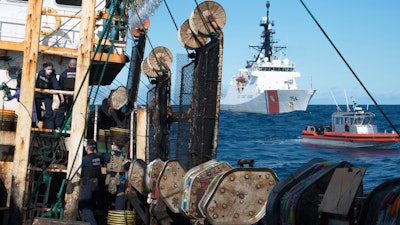
This summer, as China fired missiles into the sea off Taiwan to protest House Speaker Nancy Pelosi's visit to the island, a much different kind of geopolitical standoff was taking shape in another corner of the Pacific Ocean.
Thousands of miles away, a heavily-armed U.S. Coast Guard cutter sailed up to a fleet of a few hundred Chinese squid-fishing boats not far from Ecuador's Galapagos Islands. Its mission: inspect the vessels for any signs of illegal, unreported or unregulated fishing.
Boarding ships on the high seas is a perfectly legal if little-used tool available to any sea power as part of the collective effort to protect the oceans' threatened fish stocks.
But in this case, the Chinese captains of several fishing boats did something unexpected. Three vessels sped away, one turning aggressively 90 degrees toward the Coast Guard cutter James, forcing the American vessel to take evasive action to avoid being rammed.
"For the most part they wanted to avoid us," said Coast Guard Lt. Hunter Stowes, the highest-ranking law enforcement officer on the James. "But we were able to maneuver effectively so that we were safe the entire time."
Still, the high-seas confrontation represented a potentially dangerous breach of international maritime protocol, one the U.S. sees as a troubling precedent since it happened on the Coast Guard's first-ever mission to counter illegal fishing in the eastern Pacific.
The Associated Press reconstructed details of the never-before-reported incident from the Coast Guard and six U.S. non-military officials who spoke of the operation in greater detail but requested anonymity to avoid jeopardizing a multilateral process seeking to force China to sanction the vessels. While diplomats in China accused the Americans of acting improperly, they didn't provide their own detailed account.
The Coast Guard's unprecedented voyage was prompted by growing alarm from activists and governments in Latin America over the activities of China's distant water fishing fleet, the world's largest. Since 2009, the number of Chinese-flagged vessels spotted fishing in the south Pacific, sometimes for months at a time, has surged eightfold, to 476 last year. Meanwhile, the size of its squid catch has grown from 70,000 tons to 422,000 — a level of fishing that some scientists fear is unsustainable even for a resilient species.
As revealed in an AP-Univision investigation last year, the Chinese flotilla includes some of the seafood industry's worst offenders, with long records of labor abuse, illegal fishing and violations of maritime law. But they're being drawn to the open ocean around the Americas — where the U.S. has long dominated — after depleting fish stocks closer to home and fueled by an increasingly fierce race between the two superpowers to secure access to the world's dwindling natural resources.
The illegal fishing patrol, which took place over 10 days in August, was initially kept quiet. The Coast Guard, more than a month later, released a brief statement celebrating the mission along with photos from two ships it did manage to successfully board. But it made no mention of the three that ran away or gave any clue to the vessels' nationality – a posture the Coast Guard maintained in its conversations with the AP.
But the incident didn't go unnoticed in China.
Within days, Beijing fired off a formal written protest, according to the U.S. officials. Additionally, the issue was raised when U.S. Ambassador Nicholas Burns was summoned by China's foreign ministry for an emergency meeting over Speaker Pelosi's visit to Taiwan, one of the officials said.
China's foreign ministry told the AP that it has zero tolerance for illegal fishing and said it was the U.S. that is flouting international norms by carrying out unauthorized inspections that don't follow COVID protocols, potentially putting seafarers' lives at risk.
"The behavior of the United States is unsafe, opaque and unprofessional," the foreign ministry said in a statement to the AP. "We demand that the U.S. side stop its dangerous and erroneous inspection activities."
The Coast Guard disputes that assertion, saying all members of the boarding team, in addition to being vaccinated, were wearing masks, gloves and long sleeves.
The Biden administration also reported possible violations discovered on the two boats it did inspect to the South Pacific Regional Fisheries Management Organization, or SPRFMO, a group of 16 members — including China and the U.S. — charged with ensuring sustainable fishing in 53 million square kilometers of ocean.
One of the most serious accusations is against the Yong Hang 3, a refrigerated cargo vessel used to transport fish back to China so that smaller vessels can stay on the water for longer periods. The vessel was among those that ran from the Coast Guard patrol, disobeying direct orders to cooperate from maritime authorities in Panama, to which the vessel was flagged. To obscure activities, some vessels, especially refrigerated cargo vessels, often fly under other flags but are named, managed and docked in China.
Ultimately, if history is any guide, China's communist government is unlikely to punish a fleet of 3,000 distant water fishing vessels it views as an extension of its growing naval prowess and promotes with generous state loans and fuel subsidies.
The Coast Guard's patrol was meticulously planned, according to Lt. Stowes. The United States warned fisheries officials more than a year ago that it intended to conduct boardings in the area and filed papers showing pictures of the badges the crew would be carrying as well as the blue-and-white checkered flag the cutter would be hoisting. Five other countries, including Chile and New Zealand, have filed similar paperwork under rules allowing members fishing in the south Pacific to inspect each others' vessels.
"Just our being out there and doing the boardings really makes a statement," Stowes said.
At-sea inspections are considered a vital tool to verify that fishing vessels are following rules regarding the use of forced labor, environmentally hazardous gear and the targeting of threatened species such as sharks.
China has repeatedly blocked efforts to strengthen inspection procedures in the south Pacific. The most recent stonewalling took place last year, when China argued that fishermen would be at risk if at-sea patrols were allowed to carry firearms.
Rules adopted unanimously in 2011 are guided by a 1995 United Nations treaty, known as the Fish Stocks Agreement, that allows inspectors to use limited force to stay safe.
In a sign of how geopolitical rivalry may be escalating since the Pacific incident, one official told AP that the State Department sent a sternly-worded diplomatic note reminding Beijing of its international obligations as well as the distant water fleet's long track record of labor abuses and violations.
The Biden administration is also weighing whether it will seek to have the vessels blacklisted for illegal fishing and banned from returning to the south Pacific at an upcoming meeting in Ecuador of the fishing management organization.






















